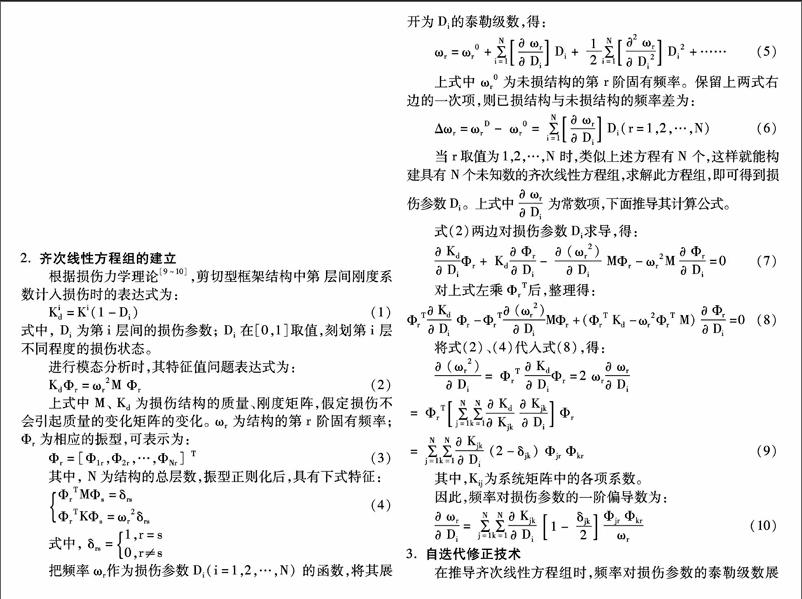剪切型框架结构的损伤识别方法之一
2018-01-05陈晋宝
陈晋宝


【摘要】开发结构健康诊断系统是结构损伤识别的一个重要课题。本文基于频率易测且精度较高的特点,提出一种剪切型框架结构损伤识别的方法。其基本思想是:把频率看作损伤参数的函数,通过测量结构损伤前后频率的变化,构造以损伤参数为未知量的齐次线性方程组,求解可以得到全部损伤的位置和程度。并进一步提出求解齐次线性方程组的自迭代技术,极大地提高了诊断损伤的精度。最后通过对一个三层框架结构进行数值模拟分析,验证了它的可行性。
【关键词】剪切型结构;损伤识别;齐次线性方程组;自迭代
【Abstract】Development of health monitoring system becomes an important task for structure damage identification. Based on the easy testability and high measure precision of structural frequency, a damage identification method for shear buildings is presented. With frequency being regarded as the function of damage parameters, the homogeneous linear equations with damage parameters as unknowns can be constructed via Taylor expansion. The equations are solved to locate the whole damage location and quantify the severity of the damage. The data used in the method include frequency and mode shape measurement before and after damage. Furthermore, the iteration-self modification is proposed to improve the accuracy of damage identification greatly. A numerical simulation example using a three-storey sheer structure is given to validate the present method.
【Key words】Shear buildings damage identification;Homogeneous linear equations;Iteration-self
1. 前言
近几十年来,涌现出许多基于振动损伤识别的方法。其原理是结构的损伤破坏通常导致刚度的降低,从而引起结构动力特性的变化。常用的诊断数据包括固有频率和振型[1~8]。本文在前人研究的基础上,提出一种剪切型框架结构损伤识别的方法。它从结构模态有限元算式出发,把每层的损伤参数作为系统的变量,以频率为损伤参数的函数,并经泰勒级数展开,取其一次项,构造以损伤参数为未知量的齐次线性方程组。求解此方程组得到结构全部损伤的位置和程度。文中推导了频率对损伤参数的一阶偏导数的计算公式。由于在构建方程组时仅取泰勒级数的一次项,必然影响其识别精度,据此提出自迭代修正技术,极大地提高了损伤识别精度。最后通过对一个三层框架结构进行数值模拟分析,验证它的可行性。
4.数值模拟计算与分析
4.1为了验证本方法的可行性和准确性,进行了一个三层的刚架结构的數值模拟计算。下图给出了一个剪切型框架(即刚性梁)和它的楼层重量和层间刚度。假设该结构产生损伤,第一、二、三层的层间刚度系数损伤分别为:0.15、0.30、0.35(计算简图见图1)。
4.2根据公式(2)计算出本结构的无损和有损三阶频率及振型,将其代入公式(6)(在实际工程中应为测量值),构建含有三个未知数的齐次方程组。求解此方程组并利用自迭代修正技术,得损伤参数值如表所示。
从表中可以看出,直接求解方程组得到的损伤参数值与真实值相比,还有较大的误差。但通过两次迭代计算,其结果就非常接近真实值了。这说明本方法可以同时准确地判定结构损伤发生的位置以及程度(见表1)。
5. 结论
(1)基于频率变化的齐次线性方程组求解的结构损伤识别,不仅可以判断结构是否有损伤,而且还可以判定损伤的位置以及损伤的程度。
(2)修正技术的应用可以很大地提高识别精度。
(3)本方法使用容易测试且测量精度较高的模态参数:频率和振型,且易于在计算机中得到实现,在工程实际中有较好的适用性。
参考文献
[1]Salawu, O. S. Detection of Structural Damage through Changes on Frequency:A Review[J], Engineering Structures, 1997, 19(9) :718~723.
[2]Pandey, A.K., Biswas, W. Samman, M. M., Damage detection from changes in curvature mode shapes,[J] Journal of Sound and Vibration,1991,Vol.3,505~517.
[3]Bernal,D. Load Vectors for Damage Localization. ASCE. Journal of Engineering Mechanics, 2002, 128(1): 7~14.
[4]Bernal, D, Gunes, B. Damage Localization in output-systems: A flexibility based approach. IMAC_XX, Los Angees, California, 2002: 1185~1191.
[5]Yong Gao, Manuel, E., Ruiz_Sandoval, Spencer, B. F., Jr, Flexibility-Based Damage Localization Employing Ambient Vibration 15th ASCE Engineering Mechanics Conference, Columbia University, New York,NY. 2002, 6:1~8.
[6]Yao,G..C. Change,K.C. and Lee,G..C. Damage diagnosis of steel frames using vibrational signature analysis, [J] Journal of Engineering Mechanics, 1992, 118(9), 1949~1961.
Stubbs N, Kim, J. T, Farrar, C. R. Field Verification of a Node Structive Damage Localization and Sensitivity Estimator Algorithm. Proceedings of the 13th International Modal Analysis Conference.1995, 210~218.
[7]Shi ZY,Law S.S.,Zhang LM. Structural damage detection from modal strain energy change [J].Journal of Engineering Mechanics, 2000, 126(12):1216~1223.
[8]Shi ZY,Law S.S.,Zhang LM. Optimum sensor placement for structural damage detection [J]. Journal of Engineering Mechanics, 2000, 126(11):1173~1179.
[9]王柏生,倪一清,高贊明.青马大桥桥板结构损伤位置识别的数值模拟.土木工程学报,2001,34(3).
[10]余天庆、钱济成编著,损伤理论及其应用,北京:国防工业出版社,1998.第35-96页.
